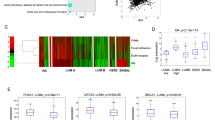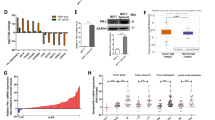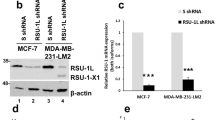Abstract
Triple-negative breast cancer (TNBC) is a highly aggressive and metastatic form of breast cancer that lacks the estrogen, progesterone and HER2 receptors and is resistant to targeted and hormone therapies. TNBCs express high levels of the transmembrane glycoprotein, complement C1r/C1s, Uegf, Bmp1 (CUB)-domain containing protein 1 (CDCP1), which has been correlated with the aggressiveness and poor prognosis of multiple carcinomas. Full-length CDCP1 (flCDCP1) can be proteolytically cleaved, resulting in a cleaved membrane-bound isoform (cCDCP1). CDCP1 is phosphorylated by Src family kinases in its full-length and cleaved states, which is important for its pro-metastatic signaling. We observed that cCDCP1, compared with flCDCP1, induced a dramatic increase in phosphorylation of the migration-associated proteins: PKCδ, ERK1/2 and p38 mitogen-activated protein kinase in HEK 293T. In addition, only cCDCP1 induced migration of HEK 293T cells and rescued migration of the TNBC cell lines expressing short hairpin RNA against CDCP1. Importantly, we found that only cCDCP1 is capable of dimerization, which can be blocked by expression of the extracellular portion of cCDCP1 (ECC), indicating that dimerization occurs through CDCP1’s ectodomain. We found that ECC inhibited phosphorylation of PKCδ and migration of TNBC cells in two-dimensional culture. Furthermore, ECC decreased cell invasiveness, inhibited proliferation and stimulated apoptosis of TNBC cells in three-dimensional culture, indicating that the cCDCP1 dimer is an important contributor to TNBC aggressiveness. These studies have important implications for the development of a therapeutic to block CDCP1 activity and TNBC metastasis.
This is a preview of subscription content, access via your institution
Access options
Subscribe to this journal
Receive 50 print issues and online access
$259.00 per year
only $5.18 per issue
Buy this article
- Purchase on Springer Link
- Instant access to full article PDF
Prices may be subject to local taxes which are calculated during checkout







Similar content being viewed by others
References
Metzger-Filho O, Tutt A, de Azambuja E, Saini KS, Viale G, Loi S et al. Dissecting the heterogeneity of triple-negative breast cancer. J Clin Oncol 2012; 30: 1879–1887.
Law ME, Corsino PE, Jahn SC, Davis BJ, Chen S, Patel B et al. Glucocorticoids and histone deacetylase inhibitors cooperate to block the invasiveness of basal-like breast cancer cells through novel mechanisms. Oncogene 2013; 32: 1316–1329.
Casar B, Rimann I, Kato H, Shattil SJ, Quigley JP, Deryugina EI . In vivo cleaved CDCP1 promotes early tumor dissemination via complexing with activated β1 integrin and induction of FAK/PI3K/Akt motility signaling. Oncogene 2014; 33: 255–268.
Uekita T, Jia L, Narisawa-Saito M, Yokota J, Kiyono T, Sakai R . CUB domain-containing protein 1 is a novel regulator of anoikis resistance in lung adenocarcinoma. Mol Cell Biol 2007; 27: 7649–7660.
Uekita T, Tanaka M, Takigahira M, Miyazawa Y, Nakanishi Y, Kanai Y et al. CUB-domain-containing protein 1 regulates peritoneal dissemination of gastric scirrhous carcinoma. Am J Pathol 2008; 172: 1729–1739.
Siva AC, Wild MA, Kirkland RE, Nolan MJ, Lin B, Maruyama T et al. Targeting CUB domain-containing protein 1 with a monoclonal antibody inhibits metastasis in a prostate cancer model. Cancer Res 2008; 68: 3759–3766.
Liu H, Ong SE, Badu-Nkansah K, Schindler J, White FM, Hynes RO . CUB-domain-containing protein 1 (CDCP1) activates Src to promote melanoma metastasis. Proc Natl Acad Sci USA 2011; 108: 1379–1384.
Casar B, He Y, Iconomou M, Hooper JD, Quigley JP, Deryugina EI . Blocking of CDCP1 cleavage in vivo prevents Akt-dependent survival and inhibits metastatic colonization through PARP1-mediated apoptosis of cancer cells. Oncogene 2012; 31: 3924–3938.
He Y, Wu AC, Harrington BS, Davies CM, Wallace SJ, Adams MN et al. Elevated CDCP1 predicts poor patient outcome and mediates ovarian clear cell carcinoma by promoting tumor spheroid formation, cell migration and chemoresistance. Oncogene 2015; e-pub ahead of print 20 April 2015 doi:10.1038/onc.2015.101.
Razorenova OV, Finger EC, Colavitti R, Chernikova SB, Boiko AD, Chan CK et al. VHL loss in renal cell carcinoma leads to up-regulation of CUB domain-containing protein 1 to stimulate PKC{delta}-driven migration. Proc Natl Acad Sci USA 2011; 108: 1931–1936.
Emerling BM, Benes CH, Poulogiannis G, Bell EL, Courtney K, Liu H et al. Identification of CDCP1 as a hypoxia-inducible factor 2α (HIF-2α) target gene that is associated with survival in clear cell renal cell carcinoma patients. Proc Natl Acad Sci USA 2013; 110: 3483–3488.
Uekita T, Fujii S, Miyazawa Y, Iwakawa R, Narisawa-Saito M, Nakashima K et al. Oncogenic Ras/ERK signaling activates CDCP1 to promote tumor invasion and metastasis. Mol Cancer Res 2014; 12: 1449–1459.
Adams MN, Harrington BS, He Y, Davies CM, Wallace SJ, Chetty NP et al. EGF inhibits constitutive internalization and palmitoylation-dependent degradation of membrane-spanning procancer CDCP1 promoting its availability on the cell surface. Oncogene 2014; 34: 1375–1383.
Bhatt AS, Erdjument-Bromage H, Tempst P, Craik CS, Moasser MM . Adhesion signaling by a novel mitotic substrate of src kinases. Oncogene 2005; 24: 5333–5343.
Brown TA, Yang TM, Zaitsevskaia T, Xia Y, Dunn CA, Sigle RO et al. Adhesion or plasmin regulates tyrosine phosphorylation of a novel membrane glycoprotein p80/gp140/CUB domain-containing protein 1 in epithelia. J Biol Chem 2004; 279: 14772–14783.
He Y, Wortmann A, Burke LJ, Reid JC, Adams MN, Abdul-Jabbar I et al. Proteolysis-induced N-terminal ectodomain shedding of the integral membrane glycoprotein CUB domain-containing protein 1 (CDCP1) is accompanied by tyrosine phosphorylation of its C-terminal domain and recruitment of Src and PKCdelta. J Biol Chem 2010; 285: 26162–26173.
Wortmann A, He Y, Christensen ME, Linn M, Lumley JW, Pollock PM et al. Cellular settings mediating Src Substrate switching between focal adhesion kinase tyrosine 861 and CUB-domain-containing protein 1 (CDCP1) tyrosine 734. J Biol Chem 2011; 286: 42303–42315.
Benes CH, Poulogiannis G, Cantley LC, Soltoff SP . The SRC-associated protein CUB domain-containing protein-1 regulates adhesion and motility. Oncogene 2011; 31: 653–663.
Leroy C, Shen Q, Strande V, Meyer R, McLaughlin ME, Lezan E et al. CUB-domain-containing protein 1 overexpression in solid cancers promotes cancer cell growth by activating Src family kinases. Oncogene 2015; 34: 5593–5598.
Benes CH, Wu N, Elia AE, Dharia T, Cantley LC, Soltoff SP . The C2 domain of PKCdelta is a phosphotyrosine binding domain. Cell 2005; 121: 271–280.
Spassov DS, Wong CH, Sergina N, Ahuja D, Fried M, Sheppard D et al. Phosphorylation of Trask by Src kinases inhibits integrin clustering and functions in exclusion with focal adhesion signaling. Mol Cell Biol 2011; 31: 766–782.
Kollmorgen G, Bossenmaier B, Niederfellner G, Häring HU, Lammers R . Structural requirements for cub domain containing protein 1 (CDCP1) and Src dependent cell transformation. PLoS One 2012; 7: e53050.
Hooper JD, Zijlstra A, Aimes RT, Liang H, Claassen GF, Tarin D et al. Subtractive immunization using highly metastatic human tumor cells identifies SIMA135/CDCP1, a 135 kDa cell surface phosphorylated glycoprotein antigen. Oncogene 2003; 22: 1783–1794.
Miyazawa Y, Uekita T, Hiraoka N, Fujii S, Kosuge T, Kanai Y et al. CUB domain-containing protein 1, a prognostic factor for human pancreatic cancers, promotes cell migration and extracellular matrix degradation. Cancer Res 2010; 70: 5136–5146.
Miyazawa Y, Uekita T, Ito Y, Seiki M, Yamaguchi H, Sakai R . CDCP1 regulates the function of MT1-MMP and invadopodia-mediated invasion of cancer cells. Mol Cancer Res 2013; 11: 628–637.
Uekita T, Fujii S, Miyazawa Y, Hashiguchi A, Abe H, Sakamoto M et al. Suppression of autophagy by CUB domain-containing protein 1 signaling is essential for anchorage-independent survival of lung cancer cells. Cancer Sci 2013; 104: 865–870.
Bork P, Beckmann G . The CUB domain. A widespread module in developmentally regulated proteins. J Mol Biol 1993; 231: 539–545.
Chaudary N, Hill RP . Hypoxia and metastasis in breast cancer. Breast Dis 2006; 26: 55–64.
Huang C, Jacobson K, Schaller MD . MAP kinases and cell migration. J Cell Sci 2004; 117: 4619–4628.
Romero A, Varela PF, Sanz L, Töpfer-Petersen E, Calvete JJ . Crystallization and preliminary X-ray diffraction analysis of boar seminal plasma spermadhesin PSP-I/PSP-II, a heterodimer of two CUB domains. FEBS Lett 1996; 382: 15–17.
Ng D, Pitcher GM, Szilard RK, Sertié A, Kanisek M, Clapcote SJ et al. Neto1 is a novel CUB-domain NMDA receptor-interacting protein required for synaptic plasticity and learning. PLoS Biol 2009; 7: e41.
Lee HX, Mendes FA, Plouhinec JL, De Robertis EM . Enzymatic regulation of pattern: BMP4 binds CUB domains of Tolloids and inhibits proteinase activity. Genes Dev 2009; 23: 2551–2562.
Gandji LY, Proust R, Larue L, Gesbert F . The tyrosine phosphatase SHP2 associates with CUB domain-containing protein-1 (CDCP1), regulating its expression at the cell surface in a phosphorylation-dependent manner. PLoS One 2015; 10: e0123472.
Choi CY, Chan DA, Paulmurugan R, Sutphin PD, Le QT, Koong AC et al. Molecular imaging of hypoxia-inducible factor 1 alpha and von Hippel-Lindau interaction in mice. Mol Imaging 2008; 7: 139–146.
Cvetković D, Goertzen CG, Bhattacharya M . Quantification of breast cancer cell invasiveness using a three-dimensional (3D) model. J Vis Exp 2014; (88) doi:10.3791/51341.
Guiro K, Patel SA, Greco SJ, Rameshwar P, Arinzeh TL . Investigating breast cancer cell behavior using tissue engineering scaffolds. PLoS One 2015; 10: e0118724.
Tu YF, Kaipparettu BA, Ma Y, Wong LJ . Mitochondria of highly metastatic breast cancer cell line MDA-MB-231 exhibits increased autophagic properties. Biochim Biophys Acta 2011; 1807: 1125–1132.
Arora R, Yates C, Gary BD, McClellan S, Tan M, Xi Y et al. Panepoxydone targets NF-kB and FOXM1 to inhibit proliferation, induce apoptosis and reverse epithelial to mesenchymal transition in breast cancer. PLoS One 2014; 9: e98370.
Lin CY, Chen HJ, Huang CC, Lai LC, Lu TP, Tseng GC et al. ADAM9 promotes lung cancer metastases to brain by a plasminogen activator-based pathway. Cancer Res 2014; 74: 5229–5243.
Seidel J, Kunc K, Possinger K, Jehn C, Lüftner D . Effect of the tyrosine kinase inhibitor lapatinib on CUB-domain containing protein (CDCP1)-mediated breast cancer cell survival and migration. Biochem Biophys Res Commun 2011; 414: 226–232.
Kollmorgen G, Niederfellner G, Lifke A, Spohn GJ, Rieder N, Harring SV et al. Antibody mediated CDCP1 degradation as mode of action for cancer targeted therapy. Mol Oncol 2013; 7: 1142–1151.
Sandercock AM, Rust S, Guillard S, Sachsenmeier KF, Holoweckyj N, Hay C et al. Identification of anti-tumour biologics using primary tumour models, 3-D phenotypic screening and image-based multi-parametric profiling. Mol Cancer 2015; 14: 147.
Qiu B, Ackerman D, Sanchez DJ, Li B, Ochocki JD, Grazioli A et al. HIF2α-dependent lipid storage promotes endoplasmic reticulum homeostasis in clear-cell renal cell carcinoma. Cancer Discov 2015; 5: 652–667.
Nieva C, Marro M, Santana-Codina N, Rao S, Petrov D, Sierra A . The lipid phenotype of breast cancer cells characterized by Raman microspectroscopy: towards a stratification of malignancy. PLoS One 2012; 7: e46456.
Kim S, Lee Y, Koo JS . Differential expression of lipid metabolism-related proteins in different breast cancer subtypes. PLoS One 2015; 10: e0119473.
Zhau HE, He H, Wang CY, Zayzafoon M, Morrissey C, Vessella RL et al. Human prostate cancer harbors the stem cell properties of bone marrow mesenchymal stem cells. Clin Cancer Res 2011; 17: 2159–2169.
Kim KH, Lee GY, Kim JI, Ham M, Won Lee J, Kim JB . Inhibitory effect of LXR activation on cell proliferation and cell cycle progression through lipogenic activity. J Lipid Res 2010; 51: 3425–3433.
Sowter HM, Raval RR, Moore JW, Ratcliffe PJ, Harris AL . Predominant role of hypoxia-inducible transcription factor (Hif)-1alpha versus Hif-2alpha in regulation of the transcriptional response to hypoxia. Cancer Res 2003; 63: 6130–6134.
Alajati A, Guccini I, Pinton S, Garcia-Escudero R, Bernasocchi T, Sarti M et al. Interaction of CDCP1 with HER2 enhances HER2-driven tumorigenesis and promotes trastuzumab resistance in breast cancer. Cell Rep 2015; 11: 564–576.
Mamat S, Ikeda J, Enomoto T, Ueda Y, Rahadiani N, Tian T et al. Prognostic significance of CUB domain containing protein expression in endometrioid adenocarcinoma. Oncol Rep 2010; 23: 1221–1227.
Razorenova OV, Castellini L, Colavitti R, Edgington LE, Nicolau M, Huang X et al. The apoptosis repressor with a CARD domain (ARC) gene is a direct hypoxia-inducible factor 1 target gene and promotes survival and proliferation of VHL-deficient renal cancer cells. Mol Cell Biol 2014; 34: 739–751.
Razorenova OV, Ivanov AV, Budanov AV, Chumakov PM . Virus-based reporter systems for monitoring transcriptional activity of hypoxia-inducible factor 1. Gene 2005; 350: 89–98.
Miroshnikova YA, Jorgens DM, Spirio L, Auer M, Sarang-Sieminski AL, Weaver VM . Engineering strategies to recapitulate epithelial morphogenesis within synthetic three-dimensional extracellular matrix with tunable mechanical properties. Phys Biol 2011; 8: 026013.
Maller O, Hansen KC, Lyons TR, Acerbi I, Weaver VM, Prekeris R et al. Collagen architecture in pregnancy-induced protection from breast cancer. J Cell Sci 2013; 126: 4108–4110.
Acknowledgements
This work was supported by NIH Award F31CA196226 to HJW. We thank Drs Alice Police and Erin Lin for providing primary TNBC tissue, Dr Peter Kaiser for MDA-MB-231 and MDA-MB-468 cell lines, Dr Dan Mercola for MDA-MB-453 cell line, Dr Xing Dai for MCF10A cell line, Dr Albert Koong for split-luciferase vectors, Dr Inder Verma for pVSVG and ΔR8.2 lentivirus packaging plasmids, Dr Jae-Won Soh for pHACE-PKCδ construct, Dr Sanford Shattil for pRC-CMV-Src construct, Dr Peter Chumakov for pLM-CMV lentiviral vector, Miranda Paley from Dr Jennifer Prescher lab and Linan Liu from Dr Weian Zhao’s lab for help with IVIS Lumina Imager, and Dr David Fruman and Dr Hung Fan for critical reading of the manuscript.
Author information
Authors and Affiliations
Corresponding author
Ethics declarations
Competing interests
The authors declare no conflict of interest.
Additional information
Supplementary Information accompanies this paper on the Oncogene website
Supplementary information
Rights and permissions
About this article
Cite this article
Wright, H., Arulmoli, J., Motazedi, M. et al. CDCP1 cleavage is necessary for homodimerization-induced migration of triple-negative breast cancer. Oncogene 35, 4762–4772 (2016). https://doi.org/10.1038/onc.2016.7
Received:
Revised:
Accepted:
Published:
Issue Date:
DOI: https://doi.org/10.1038/onc.2016.7
This article is cited by
-
Molecular mechanism by which CDCP1 promotes proneural-mesenchymal transformation in primary glioblastoma
Cancer Cell International (2022)
-
Targeting CDCP1 gene transcription coactivated by BRD4 and CBP/p300 in castration-resistant prostate cancer
Oncogene (2022)
-
Substrate-biased activity-based probes identify proteases that cleave receptor CDCP1
Nature Chemical Biology (2021)
-
Dynamic m6A mRNA methylation reveals the role of METTL3-m6A-CDCP1 signaling axis in chemical carcinogenesis
Oncogene (2019)
-
The PDGFRβ/ERK1/2 pathway regulates CDCP1 expression in triple-negative breast cancer
BMC Cancer (2018)



